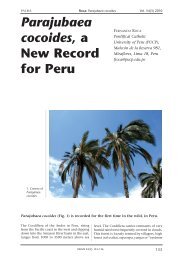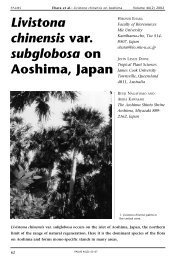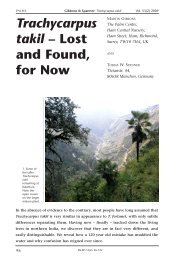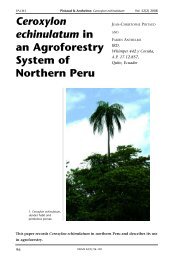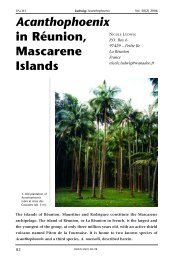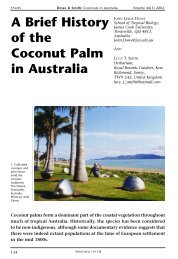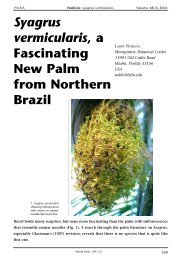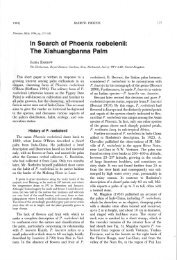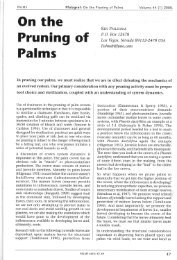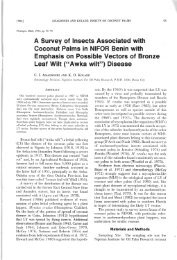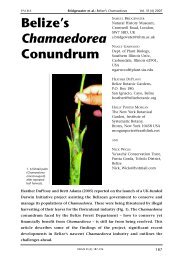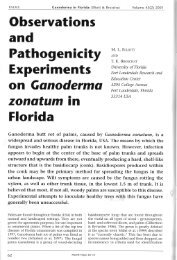Caryots - International Palm Society
Caryots - International Palm Society
Caryots - International Palm Society
You also want an ePaper? Increase the reach of your titles
YUMPU automatically turns print PDFs into web optimized ePapers that Google loves.
PALMS Dransfield et al.: Caryoto zebrino Volume 44(4) 2000<br />
The remarkable palm that forms the subject of<br />
this paper was first collected by the botanists van<br />
Royen and Sleumer on the Cyclops Mountains<br />
near Jayapura in Irian Jaya. Their specimen,<br />
deposited in Leiden Herbarium, was originally<br />
labelled Korthalsia, and the specimen thus<br />
remained mislaid in among the unidentified<br />
species of the rattan genus from New Guinea, unfll<br />
one of us (jD) realized it was a species of Caryota.<br />
However, JD, concerned at the time only with<br />
Korthalsia, did not examine the specimen in detail.<br />
Independently and much later in 1,992, another<br />
of us (GGH) saw it in cultivation, realized the palm<br />
was undescribed and gave it the informal name<br />
"Caryota zebrinz," by which it has become well<br />
known to palm growers (Fig. 1). Shortly after this,<br />
John Dowe discovered what appeared to be the<br />
same species in Vanuatu and described his<br />
Vanuatu palm as Caryota ophiopellis J. Dowe (Dowe<br />
& Cabalion 1996). Although the palm from New<br />
Guinea shares with C. ophiopellis some characters<br />
very unusual in the genus (Uhl & Dransfield 1987),<br />
they are indeed distinct. It is quite remarkable that<br />
two such strange and beautiful Caryota species<br />
should have remained undescribed for so long.<br />
Knowing that "Caryota zebrtna" had been seen by<br />
GGH in the Cyclops Mountains, two of us (RAM<br />
and CH) made field trips to collect good complete<br />
herbarium collections, the first by CH in August<br />
1998 and the second by RAM in September 1998,<br />
thus providing the necessary material for finalizing<br />
a description and to act as a type. The following<br />
paper is thus the result of a joint effort to provide<br />
a validly published name by which this now<br />
widely cultivated and highly desirable palm can<br />
be referred. The palm also occurs in Papua New<br />
Guinea (see Ferrero 1,997) where it has been<br />
collected in the Torricelli Mountains.<br />
Caryota zebrina G. Hambali, R. Maturbongs, C.<br />
Heatubun & J. Dransfield sp. nov.<br />
inflorescentia in Z-3 ordines ramificanti,<br />
endospermio homogeneo, petalis floris feminei<br />
grandibus et petiolis fasciatis C. ophiopellidi Dowe<br />
similis sed fructu majore depresso-globoso, petalis<br />
floris staminati apice rotundatis staminibus 28<br />
differt. Typus: Indonesia, lian laya, Jayapura,<br />
Cyclops Mt Nature Reserve, Doyo Village<br />
Maturbongs RAM586 (Holotypus K; isotypi BO,<br />
MAN).<br />
Solitary monoecious hapaxanthic tree palm; stems<br />
6-L6 m tall, ca. 20-4O cm diam., bare near the<br />
base, distally covered with sheaths; internodes<br />
30-40 cm long, nodal scars ca. 2 cm wide,<br />
internode surface cracking longitudinally and<br />
covered with a thick layer of dirty brown<br />
tomentum. Leaves 5-7 m long, ca. 1.5 m wide,<br />
young leaves pale green, older leaves dirty blackish<br />
green; sheath 1-2 m long, ca. 15 cm wide,<br />
markedly fibrous along margins, in mature leaves<br />
covered in dull brown tomentum, in juveniles<br />
strikingly tiger-striped with bands of pale and dark<br />
tomentum; ligule to ca. 25-60 cm long, covered<br />
in a dense layer of dirty brown tomentum, the<br />
ligule and sheath margins disintegrating into thin<br />
long black fibres; petiole ca. 1-2 m long, 2-6 x<br />
2-3 cm in cross section, in young leaves tigerstriped<br />
with bands of pale and dark indumentum<br />
as the sheath, in older leaves dark olive green;<br />
rachis to 5 m long, to 2O x 28 mm in section in<br />
midJeaf, adaxially with a strong flange ca. 8 x 5<br />
mm, abaxially convex, covered in dense caducous<br />
dark brown tomentum; primary pinnae about 20<br />
on each side if the rachis, up to ca. 20 cm apafi,<br />
the basal primary pinnae ca. 80 cm long, the midleaf<br />
primary pinnae ca. 150 cm long, the distal to<br />
100 cm long; secondary pinnae drying pale<br />
coloured, ca. 7-'J.L on each side of the secondary<br />
rachis, up to ca. 26 x 7 cm, irregularly wedgeshaped,<br />
leathery, veins radiating from the base,<br />
adaxially glabrous, abaxially with broad bands of<br />
caducous brown scales; transve$e veinlets obscure.<br />
Inflorescences 1-2.5 m long, branching to 3 orders<br />
(always?); peduncle to 30 x 40 mm diam., the<br />
surface densely covered in dull brown tomentum;<br />
distal bracts tubular, circumscissile and leaving a<br />
low collar, splitting distally to form a triangular<br />
limb to 22 x 12 cm, edged with dark brown fibres<br />
and covered in caducous brown tomentum; basal<br />
first order branches with a conspicuous pulvinus<br />
to ca. 5 cm wide; rachillae of various lengths, the<br />
longest to at least L m,3-4 mm diam., covered in<br />
dark brown indumentum; triads ca. 8-10 mm<br />
distant; rachilla bracts low, crescentic. Staminate<br />
flower at anthesis ca. L4 x 7 mm; sepals 3, dark<br />
green, strongly imbricate, irregularly gibbous,<br />
broad, rounded, entire or emarginate, the<br />
outermost 5 x 8 mm, the middle 5 x 7 mm, the<br />
innermost 5 x 7 mm, the three slightly connate<br />
basally; petals 3, free to the base, 12.0 x 4.5 mm,<br />
glabrous, smooth, almost spathulate with rounded<br />
triangular tips; stamens ca.28, filaments 3.0 x 0.3<br />
mm, anthers ora.nge 5-7 x 0.6 mm, connective<br />
dark tanniniferoris, projecting beyond the anthers<br />
as a short bifid tip to 0.5 mm; pollen monosulcate,<br />
exine semitectate with anastomosed clavae<br />
forming irregular islets of tectum (Harley, pers.<br />
comm.); pistillode absent. Pistillate flower in bud<br />
(van Royen & Sleumer 6129) superficially similar to<br />
staminate flower but narrower, ca. 10.0 x 3.5 mm<br />
except at base where 6 mm wide; sepals 3,<br />
rounded, broadly imbricate, irregularly gibbous,<br />
the outer 4 x 7 mm, the middle 4 x 7 mm, the<br />
innermost 3.5 x 6.0 mm; petals 3, free in bud, 9.0<br />
x 2.8 mm; staminodes 3, antesepalous, filaments<br />
171



